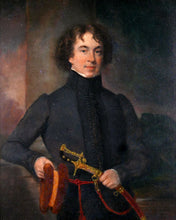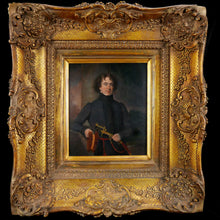Nizam of Hyderabad's Cavalry - Portrait of an Officer, 1832
- Regular price
- £2,400
- Sale price
- £2,400
- Regular price
-
- Unit price
- /per
Adding product to your cart
Overall: 46cm (18in) x 42cm (16.5in)
Oil on canvas board. Three quarter length portrait of an officer in undress uniform holding a brown peak cap in his right hand and an mameluke type sword as favoured by British light cavalry officers on campaign in the first decade of the nineteenth century and as ornamental ‘walking out swords’. Board: 25cm (10in) x 20cm (8in). Inscribed verso with artist attribution to the John Godwin Williams. Contained in period gilt wood frame.
The present portrait shares the similarities with three portraits in the National Army Museum and two in the British Library - all by John Godwin Williams. The most interesting of these of these is the portrait of Raja Chandu Lal (1766–1845), poet, soldier and Prime Minister to the 3rd Nizam of Hyderabad (1809–1843), painted in 1832. The rest are portraits of Madras Army officers, a surgeon on the Madras Medical Establishment and a divine belonging to the Bombay Ecclesiastical Establishment, all painted in 1832 and 1834, and thus dating the present portrait to this time frame.
The British had a long established presence in Muslim state of Hyderabad, reaching back to the Treaty of Mausilipatam in 1768. A British Resident Minister and a British officered subsidiary force (later known as the Hyderabad Contingent) were installed as a means of directing East India Company policy towards neighbouring states. The Nizam retained control of internal affairs. The Nizams of Hyderabad were the first of many Indian princes to follow this path. The martial qualities of the Nizam’s troops, chiefly local Hindustanis, or ‘Rohillas’ recruited from across northern India and including, Mughals, Pathans, Syeds, Sheikhs and Balochs were recognised by the Governor-General of India Lord William Bentnick in the 1830s as having the best chance of withstanding a Russian incursion, rather than the physically smaller soldiers of Madras on which the East India Company had hitherto relied.
Read more
The British presence in Hyderabad attracted John Godwin Williams, who, following in the footsteps of earlier European painters, sought commissions from British civil and military officers stationed in far flung outposts. Our sitter would have been serving with one of the four cavalry regiments of the Hyderabad subsidiary force, namely, 1st Cavalry; later 20th Deccan Horse. 2nd Cavalry, later 29th Lancers (Deccan Horse). 3rd Cavalry, later 3rd Lancers (disbanded 1903) and 4th Cavalry, later 30th Lancers (Gordon's Horse). The Nizam and Hyderabad forces remained loyal to the British during the Great Sepoy Mutiny of 1857–58.
John Godwin Williams (1793–1863) was born in Portsea, Hampshire in the year Britain went to war with revolutionary France. At the age of eighteen in 1811 the Lord Lieutenant of Hampshire granted him a commission as a Second Lieutenant in the Portsmouth Volunteer Artillery. The first known reference to him as an artist occurs in 1825 when he is listed as an exhibitor of a 'sea piece' the British Institution. By 1832 he was in India with his wife Catherine Augusta Bolton (1824-1883) and where their eldest daughter was born. In 1836 Williams was homeward bound aboard the Duke of Argyll (The Asiatic Journal and Monthly Miscellany - Volume 21 - Page 51). He is recorded as a portrait painter at Cheltenham in the 1840 and later at South Bersted, Sussex. He lived latterly at 14 Sumner Place, Brompton, London, and died at Hartney Wintney, Hampshire in 1863. His younger son Alfred Sheldon Williams (b.1842) was also a professional artist.






